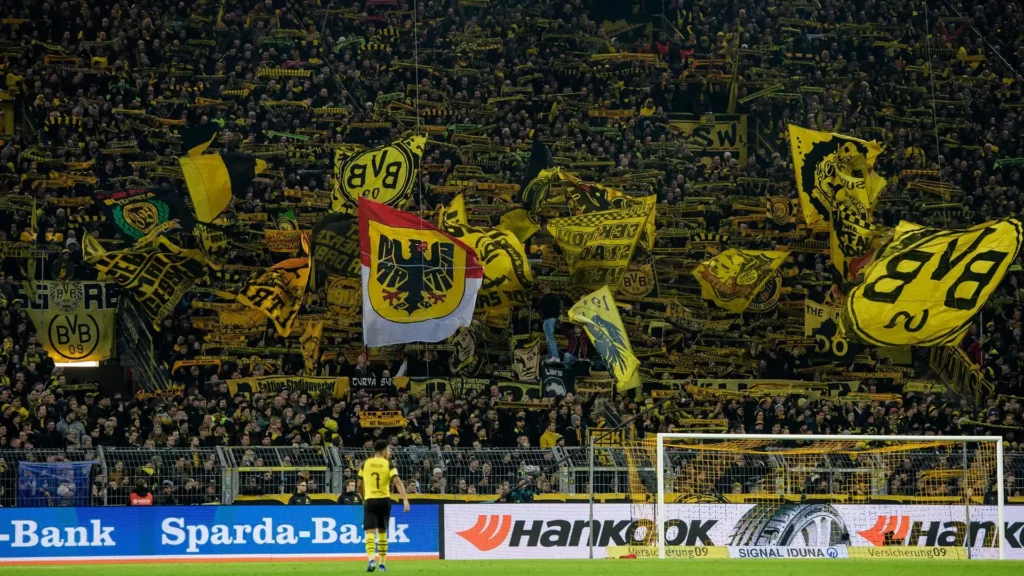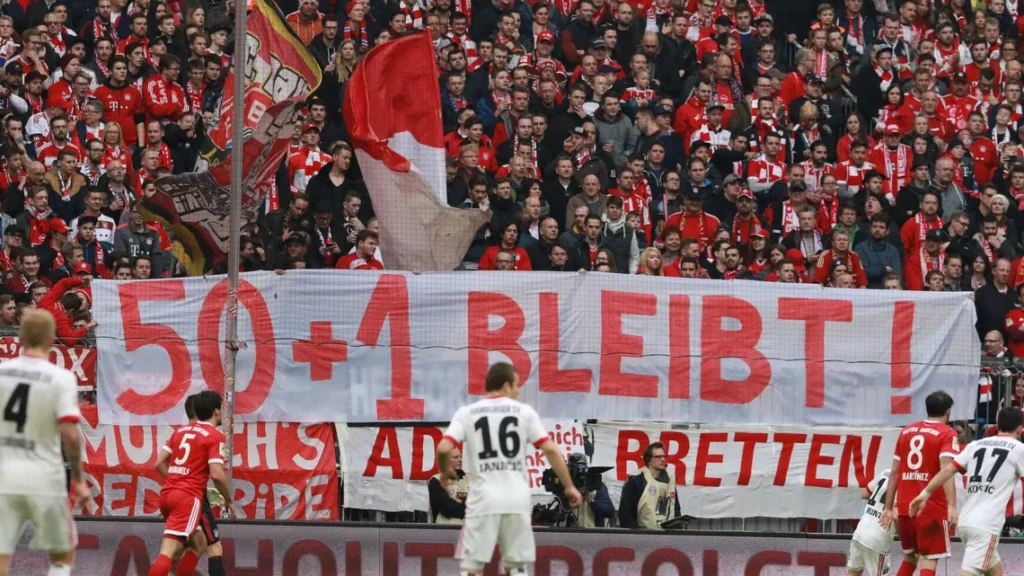The Bundesliga’s 50+1 rule is a regulation that limits the level of influence that outside investors can have on German football clubs. Under the rule, a football club must be majority-owned by its members, who hold at least 50% plus one share of the voting rights.
This means that outside investors, such as corporations or wealthy individuals, cannot take control of German football clubs or make decisions that go against the interests of the club’s members. The rule is designed to promote the long-term stability and sustainability of German football clubs, as well as to ensure that they remain closely tied to their communities and fans.
The 50+1 rule was first introduced in the 1990s and has been a central part of the governance structure of the Bundesliga ever since. While some critics argue that the rule limits the ability of German clubs to compete with other European football clubs that are owned by wealthy investors, proponents of the rule argue that it has been instrumental in promoting the success of German football both on and off the pitch.
Overall, the 50+1 rule is seen as a unique and important feature of the governance structure of German football, helping to promote the long-term stability and sustainability of German football clubs while keeping them closely tied to their communities and fans.
What are some examples of German football clubs that have been successful under the 50+1 rule?
Several German football clubs have been successful under the 50+1 rule, including:
- Bayern Munich – one of the most successful football clubs in the world, Bayern Munich has won numerous domestic and international titles while remaining majority-owned by its members.
- Borussia Dortmund – another successful German football club, Borussia Dortmund has won multiple Bundesliga titles and reached the final of the Champions League while remaining majority-owned by its members.
- RB Leipzig – a relatively new football club that has risen rapidly through the ranks of German football in recent years, RB Leipzig is majority-owned by Red Bull but still adheres to the 50+1 rule, with the club’s members retaining a significant level of control over its operations.
- FC St. Pauli – a smaller football club based in Hamburg, FC St. Pauli has a passionate fanbase and a reputation for social activism. The club has remained committed to the 50+1 rule and has enjoyed significant success both on and off the pitch in recent years.
Overall, these examples demonstrate that the 50+1 rule has not prevented German football clubs from achieving success on the pitch or from attracting investment from outside sources, while still ensuring that the clubs remain closely tied to their members and communities.
What are some other football clubs that have remained committed to the 50+1 rule?
Apart from the successful German football clubs that I mentioned earlier, there are several other football clubs in Germany that have remained committed to the 50+1 rule. Some examples include:
- Hamburger SV – a former Bundesliga champion, Hamburger SV is majority-owned by its members and has a strong fanbase that is actively involved in the club’s decision-making process.
- Hannover 96 – another club that is majority-owned by its members, Hannover 96 has a long history in German football and has remained committed to the 50+1 rule despite facing financial difficulties in recent years.
- FC Köln – a club based in the city of Cologne, 1. FC Köln has a passionate fanbase and a reputation for being one of the most traditional clubs in German football. The club is majority-owned by its members and has remained committed to the 50+1 rule despite facing some financial challenges in recent years.
- SC Freiburg – a smaller club based in the Black Forest region of Germany, SC Freiburg has a loyal fanbase and a reputation for developing young talent. The club is majority-owned by its members and has enjoyed significant success in recent years while remaining committed to the 50+1 rule.
These are just a few examples of the many German football clubs that have remained committed to the 50+1 rule, demonstrating the importance of this regulation in promoting the long-term stability and sustainability of German football clubs.

How do clubs that don’t follow the 50+1 rule differ from those that do?
Football clubs that do not follow the 50+1 rule differ from those that do in several key ways. The most significant difference is the ownership structure of the club.
In clubs that do not follow the 50+1 rule, outside investors, such as wealthy individuals and corporations, are able to take controlling stakes in the club and make strategic decisions that may not align with the interests of the club’s fans and community. This can lead to a perception that the club is more focused on financial gain than on its traditional values and identity.
In contrast, clubs that adhere to the 50+1 rule are majority-owned by their members, who hold at least 50% plus one share of the voting rights. This ensures that the club remains closely tied to its fans and community, and that decisions are made with the best interests of the club in mind.
Another key difference between clubs that follow the 50+1 rule and those that do not is the level of financial stability and sustainability. Clubs that are majority-owned by their members are generally more financially stable and less prone to financial difficulties, as they are not reliant on a single wealthy investor and can draw on the support of their fanbase.
Overall, clubs that adhere to the 50+1 rule are seen as being more closely tied to their fans and communities, and as being more focused on the long-term stability and sustainability of the club. Clubs that do not follow the 50+1 rule may be seen as being more focused on financial gain and as being more vulnerable to financial difficulties and instability.

clubs doesn’t follow 50+1 rule in Bundesliga?
There are a few football clubs in the Bundesliga that have exceptions to the 50+1 rule or have found ways to work around it, but none of them are majority-owned by external investors.
One example is RB Leipzig, which is owned by Red Bull but still adheres to the 50+1 rule. The club’s members retain a significant level of control over its operations, and Red Bull has invested heavily in the club’s infrastructure and player development.
Another example is VfL Wolfsburg, which is owned by the Volkswagen Group. While the club is technically majority-owned by its members, Volkswagen has significant influence over the club’s decision-making process due to its financial support.
However, it’s worth noting that the vast majority of clubs in the Bundesliga adhere to the 50+1 rule and are majority-owned by their members. The rule is seen as a central part of the governance structure of the Bundesliga and has been instrumental in promoting the long-term stability and sustainability of German football clubs.
There are several football clubs in Europe that do not follow the 50+1 rule, including:
- Manchester City – owned by Sheikh Mansour bin Zayed Al Nahyan of the Abu Dhabi royal family, Manchester City has become one of the most successful football clubs in the world since his acquisition in 2008.
- Paris Saint-Germain – owned by Qatar Sports Investments, Paris Saint-Germain has become one of the dominant football clubs in France and has attracted some of the world’s top players.
- Chelsea – owned by Todd Boehly, Chelsea has won multiple domestic and international titles since his acquisition in 2003.
- AC Milan – owned by US-based hedge fund Elliott Management, AC Milan has a rich history in Italian football but has struggled in recent years to compete with the top clubs in Serie A.
- Inter Milan – owned by Chinese electronics retailer Suning Holdings Group, Inter Milan has won multiple domestic titles in recent years but has struggled to make an impact in European competitions.
It’s worth noting that while these clubs do not adhere to the 50+1 rule, they have still enjoyed significant success on the pitch and have attracted significant investment from outside sources. However, some critics argue that the dominance of these clubs, and the financial resources at their disposal, contribute to a lack of competitive balance in European football.
What are some arguments against the 50+1 rule?
There are some arguments against the 50+1 rule in German football, including:
- Limiting investment: Critics argue that the 50+1 rule limits the ability of football clubs to attract investment from outside sources, which could help to improve the quality of the sport and make it more competitive on a global scale.
- Lack of innovation: Some argue that the 50+1 rule stifles innovation in German football, as outside investors may have new ideas and approaches that could help to modernize the sport and make it more appealing to fans.
- Inequality: Critics argue that the 50+1 rule contributes to financial inequality in German football, as larger clubs with more resources are better able to compete and attract top players than smaller clubs with less financial backing.
- International competitiveness: Some argue that the 50+1 rule puts German football at a disadvantage in international competitions, as clubs from other countries that are owned by wealthy investors are able to attract top talent and compete at a higher level.
It is worth noting, however, that proponents of the 50+1 rule argue that it has been instrumental in promoting the long-term stability and sustainability of German football clubs, and in ensuring that the interests of the club’s fans and community are taken into account. They also point to the success of German football clubs that have adhered to the 50+1 rule, such as Bayern Munich and Borussia Dortmund, as evidence that the rule does not necessarily limit the competitiveness of German football.


Published by